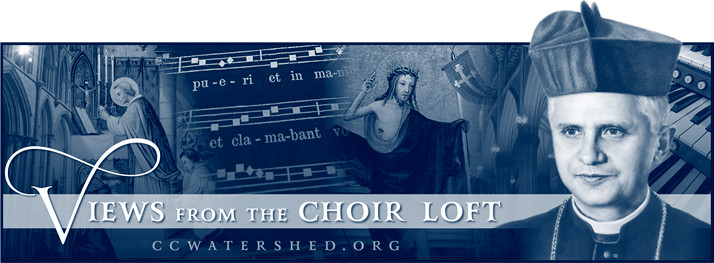 The fifth and final “highlight” I would like to share concerning the Roman Missal, Third Edition seems almost superfluous. It concerns something absurdly obvious to anyone who even glances at the pages of the new missal. There’s nothing subtle or insightful at all about this observation, since it is so plain to see. I am sharing this highlight nonetheless, since I realize that not everyone casts their eyes inside this missal everyday, as I do as a priest.
The fifth and final “highlight” I would like to share concerning the Roman Missal, Third Edition seems almost superfluous. It concerns something absurdly obvious to anyone who even glances at the pages of the new missal. There’s nothing subtle or insightful at all about this observation, since it is so plain to see. I am sharing this highlight nonetheless, since I realize that not everyone casts their eyes inside this missal everyday, as I do as a priest.
Here it is: the third typical edition of the Roman Missal is the most musical missal in history.
Hands down, no questions. It contains far more chants than any of its predecessors. This is a prodigious, breakthrough moment for lovers of chant and of the sacred liturgy. There is not a single prayer intended for audible proclamation for which music is not provided in this missal. Only the private prayers of the priest (including the offertory prayers) are left without melody.
Throughout the entire ordinary of the Mass, nearly every prayer is rendered first with musical accompaniment, and only after that does the plain text follow. This ordering, in itself, is undeniably meant to tell us something. It’s meant to tell us to sing and to chant.
There is a growing distinction being made among folks who labor in sacred music, which is probably familiar to those who browse the Corpus Christi Watershed. It is the question of whether to sing at Mass or to sing the Mass. What matters really isn’t the singing of hymns or preludes or motets. What matters is singing the proper & ordinary prayers of the liturgy, themselves.
Why? The Roman liturgy is a sung liturgy. To be sure, this has not been our experience in the typical American parish since the 1960’s. Nor, to be fair, was it the typical experience in the 40’s or 50’s, either. This is most certainly, however, the vision of Sacrosanctum Concilium. and the Second Vatican Council. It is not merely a matter of the priest’s personal preference.
The music has been provided for us. The preference for chant versus spoken prayers has been made clear. It remains for us—especially as priest celebrants—to embrace the vision set before us. This is not, of course, a paradigm shift on the part of the Church, but, for liturgical praxis on the average parish level, it certainly will be.
As Saint Augustine observes, “Only the lover sings” (Sermon 336). If we believe that the liturgy is fundamentally a movement of love and an expression of our love for God, Who, Himself, is Love, then our liturgy should be sung!

